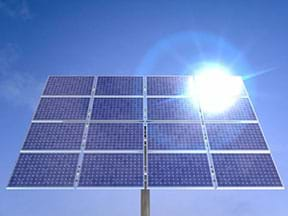
Summary
Students learn how the sun can be used for energy. They learn about passive solar heating, lighting and cooking, and active solar engineering technologies (such as photovoltaic arrays and concentrating mirrors) that generate electricity. Students investigate the thermal energy storage capacities of test materials. They learn about radiation and convection as they build a model solar water heater and determine how much it can heat water in a given amount of time. In another activity, students build and compare the performance of four solar cooker designs. In an associated literacy activity, students investigate how people live "off the grid" using solar power.Engineering Connection
Engineers who design spacecraft or satellite components know that white objects reflect the sun and stay cooler, while objects painted dark colors absorb heat and stay warmer. This is important when objects pass through the sun's shadow while orbiting Earth. Space shuttles are white on top and dark on the bottom, and components that need to remain heated are located at the bottom of the shuttle. For everyday use, engineers are designing a paint that diffuses energy and stays cool, which could serve as a heat shield in many applications since dark colors absorb enough solar heat to sometimes send surface temperature to 190 °F on a sunny day. The black still looks black, because the paint absorbs light normally across the visible spectrum, but special pigments with bits of inorganic metals reflect the infrared light, effectively turning away half of the sun's energy.
Learning Objectives
After this lesson, students should be able to:
- Differentiate solar energy as being either active or passive.
- Describe how energy can be transformed from solar energy to electrical energy.
- Explain how the sun's position changes the amount of solar energy that can be concentrated and stored.
- Explain how engineers work with solar energy and why they need to know the sun's position.
Educational Standards
Each TeachEngineering lesson or activity is correlated to one or more K-12 science,
technology, engineering or math (STEM) educational standards.
All 100,000+ K-12 STEM standards covered in TeachEngineering are collected, maintained and packaged by the Achievement Standards Network (ASN),
a project of D2L (www.achievementstandards.org).
In the ASN, standards are hierarchically structured: first by source; e.g., by state; within source by type; e.g., science or mathematics;
within type by subtype, then by grade, etc.
Each TeachEngineering lesson or activity is correlated to one or more K-12 science, technology, engineering or math (STEM) educational standards.
All 100,000+ K-12 STEM standards covered in TeachEngineering are collected, maintained and packaged by the Achievement Standards Network (ASN), a project of D2L (www.achievementstandards.org).
In the ASN, standards are hierarchically structured: first by source; e.g., by state; within source by type; e.g., science or mathematics; within type by subtype, then by grade, etc.
NGSS: Next Generation Science Standards - Science
| NGSS Performance Expectation | ||
|---|---|---|
|
4-ESS3-1. Obtain and combine information to describe that energy and fuels are derived from natural resources and their uses affect the environment. (Grade 4) Do you agree with this alignment? |
||
| Click to view other curriculum aligned to this Performance Expectation | ||
| This lesson focuses on the following Three Dimensional Learning aspects of NGSS: | ||
| Science & Engineering Practices | Disciplinary Core Ideas | Crosscutting Concepts |
| Obtain and combine information from books and/or other reliable media to explain phenomena or solutions to a design problem. Alignment agreement: | Energy and fuels that humans use are derived from natural sources, and their use affects the environment in multiple ways. Some resources are renewable over time, and others are not. Alignment agreement: | Knowledge of relevant scientific concepts and research findings is important in engineering. Alignment agreement: Over time, people's needs and wants change, as do their demands for new and improved technologies.Alignment agreement: |
| NGSS Performance Expectation | ||
|---|---|---|
|
4-PS3-2. Make observations to provide evidence that energy can be transferred from place to place by sound, light, heat, and electric currents. (Grade 4) Do you agree with this alignment? |
||
| Click to view other curriculum aligned to this Performance Expectation | ||
| This lesson focuses on the following Three Dimensional Learning aspects of NGSS: | ||
| Science & Engineering Practices | Disciplinary Core Ideas | Crosscutting Concepts |
| Identify the evidence that supports particular points in an explanation. Alignment agreement: | Energy can be moved from place to place by moving objects or through sound, light, or electric currents. Alignment agreement: Energy is present whenever there are moving objects, sound, light, or heat. When objects collide, energy can be transferred from one object to another, thereby changing their motion. In such collisions, some energy is typically also transferred to the surrounding air; as a result, the air gets heated and sound is produced.Alignment agreement: Light also transfers energy from place to place.Alignment agreement: Energy can also be transferred from place to place by electric currents, which can then be used locally to produce motion, sound, heat, or light. The currents may have been produced to begin with by transforming the energy of motion into electrical energy.Alignment agreement: | Energy can be transferred in various ways and between objects. Alignment agreement: |
International Technology and Engineering Educators Association - Technology
-
Students will develop an understanding of the effects of technology on the environment.
(Grades
K -
12)
More Details
Do you agree with this alignment?
-
Energy comes in different forms.
(Grades
3 -
5)
More Details
Do you agree with this alignment?
State Standards
Colorado - Science
-
Identify and describe the variety of energy sources
(Grade
4)
More Details
Do you agree with this alignment?
-
Use multiple resources – including print, electronic, and human – to locate information about different sources of renewable and nonrenewable energy
(Grade
4)
More Details
Do you agree with this alignment?
-
Energy comes in many forms such as light, heat, sound, magnetic, chemical, and electrical
(Grade
4)
More Details
Do you agree with this alignment?
Worksheets and Attachments
Visit [www.teachengineering.org/lessons/view/cub_energy2_lesson09] to print or download.Introduction/Motivation
Can we use the sun to help us do work? Of course we can! The type of energy we get from the sun is called solar energy. There are two types of solar energy, passive solar energy and active solar energy.

Passive solar energy is when solar energy is used to light something or heat something without requiring electrical or mechanical components. Passive solar energy includes lighting a house using windows or skylights (see Figure 1), or heating a house by positioning it to receive the most direct sunlight during the cold season and minimize the solar gain from the sun during the warm season. People have used passive solar design for a long time. Hundreds of years ago, Native Americans built their houses inside cliffs, which was an innovative passive solar energy design. The cliff dwellings at Colorado's Mesa Verde National Park kept their inhabitants cool in the summer and warm in the winter (see Figure 2).
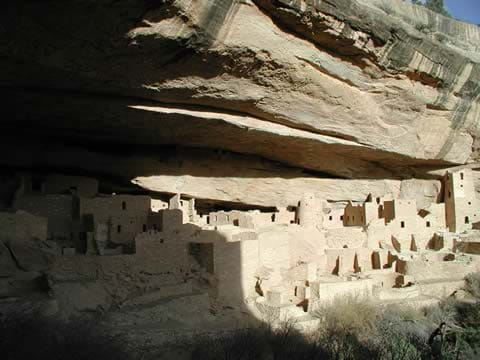
Active solar energy is when energy from the sun is transformed into electrical or mechanical energy, which is used to run fans, pumps and electrical controls. Engineers design the solar energy technologies to generate electricity from sunlight. One of the most successful uses of solar energy is to run an engine or a generator. Have you ever deliberately stood in the sun to warm up? Have you ever touched a piece of metal after it had been sitting in the sun? It's hot! Some solar power plants produce electric power by changing the sun's energy into high-temperature heat using mirrors or solar panels. The heat is channeled through a generator and changed into electricity that we can use in our homes to run TVs and refrigerators.
The most common type of solar power plant is a power tower system. The sun's energy is concentrated by a field of hundreds or even thousands of mirrors (called "heliostats") onto a solar panel receiver located on top of a tower. When the energy heats up molten salt flowing through the receiver, the salt's thermal energy generates electricity in a conventional steam generator. Use a browser for photographs of the 144 heliostats in the University of California-Davis's CACTUS solar power plant in the Mojave Desert.
When is the best time of day for solar energy? Well, during the day, when the sun is out! Since people use electricity 24 hours a day, but solar power cannot be generated at night or when it is very cloudy, engineers design solar power plants to store energy, too. They use molten salt because it retains thermal energy well and can be stored for hours or even days until it is needed to generate electricity.
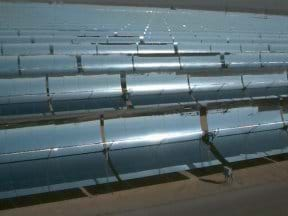
Another type of solar concentrator designed by engineers is a trough system. In it, the sun's energy is concentrated with mirror reflectors shaped like a trough or a rain gutter (parabolic), onto a receiver pipe running along the middle of the inside of the curved surface (see Figure 3). The sun's energy heats oil flowing through the pipe and the heat energy generates electricity in a conventional steam generator.
The southwestern region of the U.S. offers the best development opportunity for solar technology. Why do you think this is? Well, it is pretty sunny there! For example, if an area about one-tenth the size of the state of Nevada — a plot of land 100 miles (161 km) on a side — was covered with parabolic trough systems, enough electric power for the entire U.S. could be generated! This region is also where the most amount of electricity is used in the hot summer months when air conditioning is in heavy use. When do we use the most air conditioning? In the hottest part of the day — which is also the sunniest time of the day. These high amounts of energy demand (peak loads) happen at the same time that solar concentrators produce the most energy, so, solar power plants are well matched to meet summer electricity demand.
When do you think is the best time of day to obtain the most solar energy? Best month? Best season? Best direction — north, south, east or west? Well, the sun changes its position every day of the year, and the best direction to orient a solar panel depends on the time of the day and the day of the year. Engineers need to understand the movement of the sun to determine when and where to get the most energy from the sun. The answer to all of these questions is: when the sun is directing most energy our way!
Another way to capture solar energy is with photovoltaic cells (also called solar cells or PV cells). Have you ever used a solar calculator? Engineers designed a solar cell in the calculator to convert light energy into power. Photovoltaic cells are considered expensive and are usually made from silicon crystals. Many PV cells are often linked together to make solar panels. They use sunlight to power satellites, lights, road signs and household appliances. You may have seen them on roofs. The photovoltaic system for a home might require a dozen panels while a calculator may have only one PV cell.
All over the world, engineers are investigating and designing solar energy systems because the sun is a renewable energy source that offers promise as an inexhaustible source of electricity. While sunny locations area good place to study how solar energy works, we need to figure out how we can use solar energy in cloudy or cooler places as well. Following the lesson students can conduct the associated activities Capturing the Sun's Warmth and Design a Solar City to further explore the possibilities of using solar energy in local communities, along with the other associated activities mentioned in the background section.
Lesson Background and Concepts for Teachers
See the attached Solar Geometry Reading for background on the sun and an introduction to how engineers determine the sun's position in the sky throughout the year for any location.

Using the Sun to Regulate Building Temperature — Passive Solar Design
Passive solar buildings are oriented in an east/west direction to allow the most sunlight to enter the building during the winter and keep it out during summer. In the temperate latitudes, the sun is low in the sky in winter and high in the sky in summer. Overhangs on windows reduce excess heating in summer while allowing in all the sunlight in during winter, thus warming the building. In the northern hemisphere, overhangs are most important on windows on the south and west sides of buildings.
In parts of the world in which people can afford window glazing, passive solar design includes larger windows on the south side of the building in the northern hemisphere or on the north side in the southern hemisphere. Typically, fewer and smaller windows are used on the other sides of the building. Well-insulated, double- or triple-pane windows are best for solar applications, particularly with appropriate coatings, because they allow sunlight to transmit to the inside during the cold season and reflect heat during the warm season.
The use of insulation is very important for successful passive solar design in temperate climates. Wall and roof insulation reduces the need for both heating and cooling because it minimizes heat transfer between the building interior and the outdoors. Insulation — whether fiberglass, straw, foam or a thick masonry wall — helps to maintain a building's temperature.
The presence of thermal mass — such as adobe, water, concrete, bricks, tile, stone — helps to maintain a building's temperature. Floors and walls made of these materials keep buildings warm at night by releasing the energy they gained from sunlight during the day. In the summer, thermal mass keeps buildings from getting too hot if they are cooled at night (night ventilation). Good air exchange, or ventilation, is very important to efficiently cool a building in summer.
In the northern hemisphere, deciduous trees on the south and west sides of a building provide shade on warm afternoons, reducing the need for cooling. In the winter, deciduous trees lose their leaves and no longer block the sunlight from entering the building to warm it.
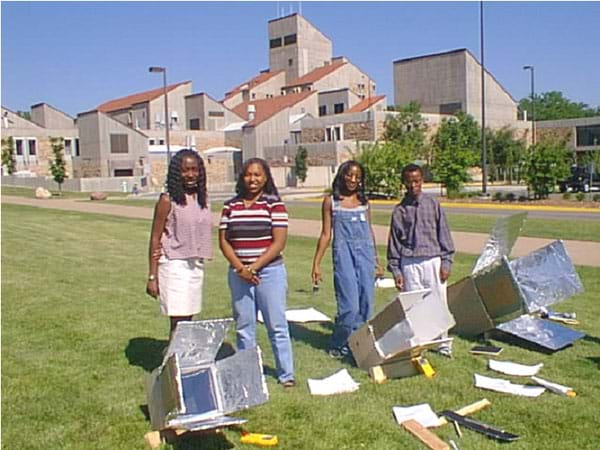
Passive solar design is used in most parts of the world, but it works best in places with clear skies. It is used most commonly for smaller buildings and homes, although some aspects (such as daylighting, shading, etc.) are incorporated into commercial structures. In cold climates, passive solar design maximizes heating from the sun; in hot climates, it minimizes heating from the sun. Passive solar buildings do not cost more than conventional buildings if they are designed by a knowledgeable engineer or architect. And, passive solar buildings save their occupants money over their lifetime with reduced energy bills.
See Solar Technologies Pros & Cons to learn the advantages and disadvantages of using passive solar building design.
Using the Sun to Heat Water
The two types of solar water heating systems are: active and passive. Active solar water heating systems use electric pumps, valves and controllers to circulate the fluid through the collector. Active systems circulate either water or a heat-transfer fluid through the collector. Passive solar water heaters rely only on convection to circulate warmed water. Refer to the associated activity Design and Test Model Solar Water Heaters for students to apply their engineering skills to explore different ways of using solar energy by building a model solar water heater and determining how much it can heat water in a given amount of time.
In solar water heaters, a fluid is exposed to the sun in a collector. If water is heated directly by the sun, then it is stored for use, as needed. If a heat-transfer fluid, such as a water/antifreeze mixture, is used, water is warmed by a heat exchanger coil placed in the storage tank.
Unfortunately, solar water heaters cannot always meet the hot water demand of a home, so often conventional water heaters provide additional heating of the stored water. Typical solar water heaters reduce the need for conventional water heating by about two-thirds. Today's solar water-heating systems provide 40-80% of a typical household's hot water demand, depending on the local climate, system size and type.
See Solar Technologies Pros & Cons to learn the advantages and disadvantages of using solar water heating systems.
Photovoltaic Systems — Electricity from the Sun
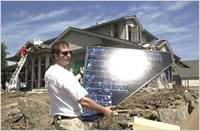
Photovoltaic (PV) cells, commonly called solar cells, have been powering satellites for decades. Most people have seen solar cells on calculators, and road signs and lights along roadways. Photovoltaic cells use sunlight to make electricity. Using photovoltaic cells to produce electricity does not produce the polluting emissions that conventional power plants produce. Conventional fuels require costly operations to extract, while sunlight is freely available everywhere. Unfortunately, photovoltaic cells are expensive because the manufacturing process is difficult. Engineers and scientists are working to make solar electricity feasible for everyone. One promising development is making PV cells from thin films rather than single silicon crystals — a technique that should make photovoltaic systems more affordable. The advantages and disadvantages of using solar electricity systems are many (see Table 1).
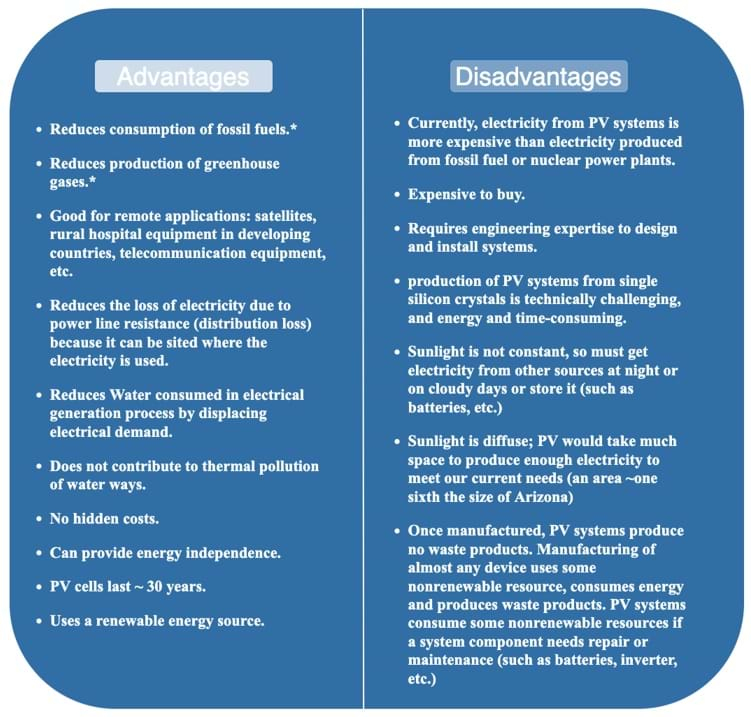
In the big picture, solar energy has great potential. "Providing mass access to solar energy generation could have wide-reaching impact. When the cost of solar cells goes down enough, it could become a 'disruptive technology.' Just like autos were disruptive to the horse and buggy business, and PCs were disruptive to the typewriter industry, some believe solar electric systems will be disruptive to the energy industry." Source: National Geographic magazine, August 2005, pg. 18.
The design, production and installation of photovoltaic systems require many different types of engineers. Materials engineers, electrical engineers and physicists develop the materials and circuitry of the photovoltaic cells. Mechanical engineers, materials engineers and manufacturing engineers design the systems that produce PV cells. Electrical engineers and civil engineers design photovoltaic systems for homes and businesses.
Photovoltaic cells can only be made of certain materials, called semiconductors, which are between conductors and insulators in their ability to conduct electricity. Silicon is the most commonly used semiconductor in photovoltaic cells. Whenever light hits a PV cell, some of the energy is absorbed by the cell. This energy can knock electrons loose from the atoms of the material. An electrical device on the PV cell forces these loose electrons to move in a particular direction, thus creating an electric current. Metal contacts at the top and bottom of a photovoltaic cell — like the terminals on a battery — connect the PV cell to an electric circuit. This circuit may be the electrical system of a building or a single device. PV cells produce direct current, DC — current in one direction only — just like a battery. Most household appliances use alternating current, AC, although many DC appliances can now be purchased. An inverter modifies the DC output of a PV cell to produce alternating current. PV cells can be linked together in different ways to make panels with different characteristics. The photovoltaic system for a home might require a dozen panels while a calculator may have only one PV cell.
Solar electric systems for homes and businesses can be linked to the utility grid (called grid-tie or utility-interface systems) or be utility independent (called stand-alone systems). In stand-alone systems, the consumer produces all their own electricity with PV or a combination of PV and wind, micro-hydro or diesel generators. Most stand-alone systems require batteries to store electricity for use during the night and cloudy periods. In grid-tie systems, the consumer uses electricity produced by their solar panels, sells excess electricity to the utility company, and can buy electricity from the utility, as necessary. Grid-tie systems may or may not have battery storage.
Students can further investigate the usage of solar energy in homes with the associated activities Cooking with the Sun: Comparing Yummy Solar Cooker Designs and Power to the People.
Associated Activities
- Capturing the Sun's Warmth - In the exploration of ways to use solar energy, students investigate the thermal energy storage capacities of different test materials to determine which to use in passive solar building design.
- Cooking with the Sun: Comparing Yummy Solar Cooker Designs - Students learn about using energy from the sun for heating and cooking as they build and compare the performance of four solar cooker designs.
- Design and Test Model Solar Water Heaters - To explore different ways of using solar energy, students build a model solar water heater and determine how much it can heat water in a given amount of time. Solar water heaters work by solar radiation and convection.
- Design a Solar City - Students teams design and construct model buildings powered by mini photovoltaic panels, learning how engineers integrate PV panels into the design of buildings.
- Power to the People - Students read and evaluate descriptions of how people live "off the grid" using solar power to understand better the degree to which that lifestyle is or is not truly independent of technological, economic and cultural infrastructure and resources. In the process, students develop a deeper appreciation of the meaning of "community" and the need for human connection. Suitable for fifth-grade and older students.
Lesson Closure
Lead students in a discussion of the advantages and disadvantages of using different solar technologies (see Table 1. Advantages include: renewable source of energy, little pollution, useful in many ways. Disadvantages include: Can be costly to develop technologies, need to have available sunlight, etc.). Engineers need to know a lot about the sun's energy and the position of the sun to develop useful solar energy technologies and make the sun work for us. Ask students to consider which solar technologies they would like to use and under what circumstances they would consider using different solar technologies. Have students explain their rationale for wanting to use or not wanting to use the solar energy activities (solar heater and solar cooker) in their everyday lives.
Vocabulary/Definitions
absorb: To be taken into a material without transmission or reflection.
active solar: Solar energy generating systems that require electrical or mechanical components, such as fans, pumps and electrical controls. These systems can be used for heating water or heating/cooling buildings.
convection: The transfer of thermal energy in a fluid (gas or liquid) by the circulation of currents in the heated fluid causing warmer packets to rise while cooler packets sink.
energy: The ability to do work.
generator: A device that transforms mechanical energy into electrical energy.
heat exchanger: A device, such as an automobile radiator, that transfers heat from one liquid to another without allowing them to mix.
heat-transfer fluid: A fluid circulated in a heat exchanger; this fluid gains energy from one region and transfers it to another region.
insulation: A material used to prevent the passage of heat, electricity or sound; a non-conducting material.
light energy: Visible light energy, such as from the sun, light bulb, fireflies, computer screens or stars, is one form of electromagnetic energy. Others forms include infrared, ultraviolet, radio and x-ray. Your eyes are detectors of visible light energy.
passive solar: Solar energy generating systems that do not require electrical or mechanical components. These systems directly heat water or buildings, or reduce solar heat gain of buildings (for example, with window awnings to keep buildings cool).
photovoltaic cell: (PV) See solar cells.
photovoltaic system: A system that converts solar energy into electricity.
reflect: To cause to bend back or return upon striking a surface.
renewable energy: Energy that is made from sources that can be regenerated. Sources include solar, wind, geothermal, biomass, ocean and hydro (water).
solar cells: Semiconductor devices that convert the energy of sunlight into electric energy. Also called photovoltaic cells or PV cells.
solar energy: Energy from the sun.
solar panel: A group of connected solar cells.
thermal mass: Materials that store thermal energy, such as water, concrete or brick.
transmit: To allow to pass through a material.
ventilation: To admit fresh air into a space; to replace existing air.
Assessment
Pre-Lesson Assessment
Brainstorming: As a class, have students engage in open discussion. Remind them that in brainstorming, no idea or suggestion is "silly." All ideas should be respectfully heard. Take an uncritical position, encourage wild ideas and discourage criticism of ideas. Have students raise their hands to respond. Write their ideas on the board. Ask:
- What are ways that solar energy can be used? (Possible answers: Heating buildings, heating water, cooking, by eating plants/other animals, by using wind or water to do work, to make electricity.)
Post-Introduction Assessment
Voting: Ask a true/false question and have students vote by holding thumbs up for true and thumbs down for false. Tally the votes and write the totals on the board. Give the right answer.
- True or False: We can use energy that comes from the sun. (Answer: True. Solar energy can be used in many ways.)
- True or False: Passive solar energy uses electrical components to do work. (Answer: False. Passive solar energy does not require electrical or mechanical components.)
- True or False: Solar energy is changed into electrical energy in a power plant using mirrors. (Answer: True. Solar energy in a power plant is converted to electrical energy using mirrors and solar panels.)
- True or False: Engineers need to know about the position of the sun in the sky to design effective solar technologies. (Answer: True. Engineers need to understand the sun's movement through the sky to develop solar technologies that work year round.)
Lesson Summary Assessment
Help Them Out! Have students pretend to be civil engineers who are working with a developing country that has no funds for electrical appliances. First, have the students think about all the basic things that people need to do during the day, then make a list of appliances that they would regularly use to make those things happen. (For example, a stove to cook breakfast, hot water faucets to clean dishes, clothes, people, etc.) Next, have the students think about whether any of these things could be done using solar energy to help. Could they use the sun to heat water, light a house, cook food, heat a school or dry clothes? Have them create a plan or poster for what they would do to help the community use solar energy to accomplish these tasks.
Send-A-Problem: Have students write their own questions about heating with solar energy. Each student on a team creates a flashcard with a question on one side and the answer on the other. If the team cannot agree on the answer they should consult the teacher. Pass the flashcards to the next team. Each member of the team reads a flashcard and everyone attempts to answer it. If they are right, they can pass the card on to another team. If they feel they have another correct answer, they can write it on the back of the flashcard as an alternative answer. Once all teams have tested themselves on all the flashcards, clarify any questions.
Lesson Extension Activities
Have student teams make posters about the components of passive solar design. Invite other classes to a poster session at which students discuss the topic they have chosen.
Ask students to research building techniques and materials used around the world. Which systems use components of passive solar design?
Have students prepare short reports or presentations about the alternative building systems using pass or solar energy. What are their characteristics, advantages and disadvantages?
To provide the students with a more detailed understating of the importance of geometry and astronomy in passive solar design, explain to them the concepts described in the Solar Geometry Reading.
Have teams of students make posters about different solar technologies or aspects of solar systems (such as the importance of thermal mass in passive solar design, stand-alone vs. grid-tie photovoltaic systems, etc.). Invite other classes to a poster session at which students discuss their topic.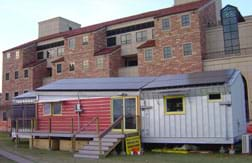
Organize a tour of a home or facility that uses one or more solar technologies.
Invite a solar designer/engineer to give a presentation to the class.
Have students design posters for a campaign to get Americans to use more solar energy.
Ask students to research the U.S. Department of Energy's Solar Decathlon, https://www.solardecathlon.gov/ — an international competition among college teams to design the most attractive and effective solar-powered house. What building designs, techniques and materials are used to create a house that produces more than enough energy for its own needs and is comfortable enough to support today's lifestyle needs (cooking, heating, hot water, home office, television, car)? What bio-based materials and recycled or re-used materials do the engineering and architecture students use to minimize overall energy use and environmental impact? Would you live in an off-the-grid house like these?
Subscribe
Get the inside scoop on all things TeachEngineering such as new site features, curriculum updates, video releases, and more by signing up for our newsletter!More Curriculum Like This

Students are introduced to passive solar design for buildings — an approach that uses the sun's energy and the surrounding climate to provide natural heating and cooling. They learn about some of the disadvantages of conventional heating and cooling and how engineers incorporate passive solar design...

Students learn and discuss the advantages and disadvantages of renewable and non-renewable energy sources. They also learn about our nation's electric power grid and what it means for a residential home to be "off the grid."

Students learn about the daily and annual cycles of solar angles used in power calculations to maximize photovoltaic power generation. They gain an overview of solar tracking systems that improve PV panel efficiency by following the sun through the sky.

Students calculate the amount of solar energy available at a given location and time of day on Earth. They learn the importance of determining incoming solar energy for solar devices.
References
Aldous, Scott. How Solar Cells Work. How Stuff Works, Inc. www.howstuffworks.com/solar-cell.htm Accessed November 9, 2005.
Dictionary.com. Lexico Publishing Group, LLC. Accessed November 9, 2004. (Source of some vocabulary definitions, with some adaptation.)
Distributed Energy Program. Updated November 9, 2005. Energy Efficiency and Renewable Energy, U.S. Department of Energy. www.eere.energy.gov/de/ Accessed November 9, 2005.
Exploring Ways to Use Solar Energy. Updated September 12, 2005. Consumer's Guide to Energy Efficiency and Renewable Energy, Energy Efficiency and Renewable Energy, U.S. Department of Energy. http://www.eere.energy.gov/consumer/renewable_energy/solar/index.cfm/mytopic=50011 Accessed November 9, 2005.
Goswami, D.Y., Kreith, F. and Kreider, J. F. Principles of Solar Engineering (Second Edition). Taylor and Francis Publishers, January 2000.
Kagan, S. Cooperative Learning. San Juan Capistrano, CA: Kagan Cooperative Learning, 1994. (Source of Send-A-Problem assessment tool)
Kids' Info. Renewable Energy for a Sustainable Future, Solar Energy International. (http://www.solarenergy.org/resources/kids.html) Accessed November 9, 2005.
Passive Solar Home Design. Updated September 12, 2005. Consumer's Guide to Energy Efficiency and Renewable Energy, Energy Efficiency and Renewable Energy, U.S. Department of Energy. http://www.eere.energy.gov/consumer/your_home/designing_remodeling/index.cfm/mytopic=10250 Accessed November 9, 2005.
Passive Solar Design: A Sourcebook for Green and Sustainable Design. Updated October 16, 2004. Sustainable Building Sourcebook, Green Building Program, Sustainable Sources. www.greenbuilder.com/sourcebook/PassiveSol.html Accessed November 9, 2005.
Snow, T. P. The Dynamic Universe: An Introduction to Astronomy. MN: West Publishing Co., 1988, pg. 658.
The Solar Cooking Archive. Solar Cookers International. http://www.solarcooking.org Accessed November 9, 2005.
Solar Energy Technologies Program. Updated November 9, 2005. Energy Efficiency and Renewable Energy (EERE), U.S. Department of Energy. http://www.eere.energy.gov/solar/ Accessed November 9, 2005. (See information on concentrating solar power, photovoltaics, solar heating and solar lighting)
Steen, A. S., B. Steen, D. Bainbridge and D. Eisenberg. The Straw Bale House. White River Junction, VT: Chelsea Green Publishing Co., 1994, pg. 297.
Copyright
© 2005 by Regents of the University of ColoradoContributors
Xochitl Zamora-Thompson; Sabre Duren; Jeff Lyng; Malinda Schaefer Zarske; Denise W. CarlsonSupporting Program
Integrated Teaching and Learning Program, College of Engineering, University of Colorado BoulderAcknowledgements
The contents of this digital library curriculum were developed under grants from the Fund for the Improvement of Postsecondary Education (FIPSE), U.S. Department of Education and National Science Foundation (GK-12 grant no. 0338326). However, these contents do not necessarily represent the policies of the Department of Education or National Science Foundation, and you should not assume endorsement by the federal government.
Last modified: January 28, 2021











User Comments & Tips